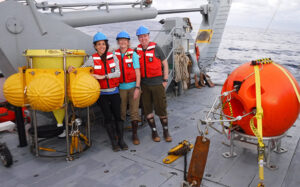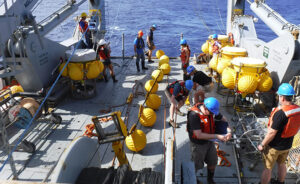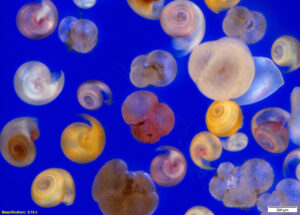A Time-series Success Story

A renewed grant will provide ongoing support for the members of the Oceanic Flux Program time-series, including BIOS faculty member and organic geochemist Maureen Conte (center), as well as colleagues JC Weber (right) and Rut Pedrosa Pàmies. With a lengthening temporal record, investigators can put observed particle flux patterns into perspective to understand key facets of the interplay between climate and ocean functioning. (Photo by A. Bochdansky)
The Oceanic Flux Program (OFP), one of the world’s longest-running time-series, has received continued funding to help the oceanographic community answer ongoing questions about the connections between climate and the particle debris that sinks through the ocean’s water column. This process, called the particle flux, is a major control on the global carbon cycle and provides the fuel to support most biological processes operating within the ocean’s deep interior.
Since 1978, sediment traps on the OFP’s mooring have continuously collected the particle flux at three depths up to 10,500 feet (3,200 meters) at a location about 45 miles (75 kilometers) southeast of Bermuda in the Sargasso Sea. Twice each year, the OFP team sails on research vessel Atlantic Explorer to recover the mooring, retrieve the flux samples, service the mooring, reload sample bottles, and redeploy the mooring for another six months of sampling.
The $2.4 million award, granted in October 2021 by the U.S. National Science Foundation Chemical Oceanography program, provides three more years of funding to support the OFP’s seagoing efforts, staff, and detailed analyses of the changing magnitude and composition of the particle flux in the deep ocean.
Why ocean particles matter
The particle flux consists of a mixture of the sinking organic and skeletal debris of plankton, as well as microscopic minerals that are deposited on, or become incorporated into, sinking debris as particles are recycled within the water column. These include land-derived materials transported into ocean gyres by currents or winds, minerals precipitated within the water column, and dissolved compounds that adhere to particle surfaces.
The magnitude and composition of the deep-ocean particle flux is intimately linked to the interactions between climate and the ocean’s biology, physics, and chemistry. The OFP’s continuous integrated measurements of the particle flux provide a unique, ongoing record of how ocean processes change on various time scales, ranging from days to decades.
The OFP has provided direct evidence for the close coupling between the upper and deep ocean via the particle flux, and has elucidated key linkages between the deep ocean and overlying phytoplankton productivity, ocean physical variability, and the impact of short-lived weather events such as extreme storms.
As the time-series enters its fourth decade, the OFP provides evidence of how the deep ocean is intimately connected with large, basin-scale climate patterns.
“We increasingly look to the OFP to tell us about how extreme weather events, like hurricanes, affect key ocean processes and the particle flux,” said BIOS faculty member and organic geochemist Maureen Conte, who has led the OFP time-series for 25 years. The OFP’s length, continuity and multifaceted information also provides an unsurpassed resource to investigate the ocean’s sensitivity to more long-lived events on a broader, ocean-basin scale and to a changing climate.”

Every six months the OFP mooring is recovered on the deck of research vessel Atlantic Explorer to service equipment, retrieve and reload flux sample bottles, and reprogram mooring instruments. The three conical instruments are the OFP’s sediment traps. The total sampling hiatus is less than 48 hours before the traps are back at depth and sampling again. (Photo by Sophia Martini)
How the OFP monitors the deep
To measure the particle flux in the deep ocean, Conte and her team use a subsurface mooring that is anchored in 2.7 miles (4,500 meters) of water and extends upward to 984 feet (300 meters) below the surface. The wire rope mooring line has flotation attached to keep it vertical, and conical sediment traps secured at three depths (1,640; 4,900; and 10,500 feet or 500; 1,500; and 3,200 meters) that continuously collect the particle flux. Other specialized instruments on the mooring measure the seawater’s physical and chemical properties, such as temperature, salinity, and dissolved oxygen.
At the top of the mooring, an instrument called an Acoustic Doppler Current Profiler (ADCP) continuously profiles the speed and direction of currents in the overlying water column up to the surface to monitor the passage of ocean eddies and fronts. During each mooring turnaround cruise, the OFP team uses the ship’s GPS navigation to locate the mooring position. Just before dawn, they lower a special acoustic transducer mounted below the ship to communicate with acoustic releases, attached near the bottom of the mooring at 13,000 feet (4,000 meters) depth. Then they send a coded signal to one of the releases to activate the process that drops the anchor and allows the mooring to rise to the surface.
When it reaches the surface, a radio, flasher, and Iridium satellite transmitter mounted on the ADCP buoy begin signaling so the team can locate the mooring and begin recovery operations.
“Recovery is a full, long day,” Conte said.
After the mooring is on deck, the team retrieves the flux sample bottles on the sediment traps, downloads stored data from the instruments, and services the equipment. Finally, they reload fresh sample bottles and reprogram the instruments to ready the mooring for redeployment. Typically, by the next day, the mooring is redeployed and descends again through the water column to begin sampling that night, a total sampling hiatus of less than 48 hours.
Providing broader support
The new funding will also allow the OFP to continue to offer operational support for researchers and educational programs throughout the oceanographic community. Hundreds of research collaborators and students worldwide have participated on OFP cruises or have utilized OFP samples and data in their studies, Conte said.
There is also increasing focus on research using the OFP archive of physical samples and more recently digital images, to look at ocean conditions from the program’s early years. “The OFP archive is an unparalleled resource for studies of the biogeochemical consequences of changing ocean chemistry,” Conte said.
Finally, the new funding will support continued hands-on training of the next generation of scientists, from the high school laboratory assistants and undergraduate researchers who work in the Conte lab to the graduate students and postdoctoral candidates who participate on OFP cruises.

A microphotograph of sinking shells of foraminifera and pteropods collected by the OFP trap at 1,640 feet (500 meters) depth in early November 2019. Carbonate and silica shells of microplankton are important contributors to the deep ocean particle flux. (Photo provided by Maureen Conte)
Looking ahead
During the next three years and beyond, Conte said the OFP will continue to exploit new ocean technologies and analytical tools to address questions about particle flux generation and cycling within the interior.
OFP research collaborator Alexander Bochdansky, a professor in Ocean and Earth Sciences at Old Dominion University in Virginia, has been joining OFP cruises to deploy cameras under development to separate different particle types, each associated with its own range of settling velocities. This research is important as alterations in material settling rates in the water column as particles are recycled affects the composition of the particle flux.
The cameras, including one mounted on the OFP mooring, compare the size and physical form of particles to their actual sinking rates to determine if their appearances can reveal information about their sinking rates. For example, a 20-micrometer dust particle with a high titanium content and four times the excess density of seawater sinks much faster than a much larger copepod fecal pellet with a length of 200 micrometers, he said. “But an even larger aggregate of 4 millimeters buoyed by gelatinous material or air bubbles may sink even slower or not at all,” he said.
OFP scientist Rut Pedrosa Pàmies, at the Marine Biological Laboratory’s Ecosystems Center in Massachusetts, has focused her research on the impact of hurricanes on the deep ocean particle flux and the fate of the tons of plastics from land that enter into the ocean each year.
The main goal of the plastics project is to understand how plastics entering the ocean interior are physically and chemically modified by the physical and chemical conditions in the water column and by the microbial communities that colonize the plastic surfaces, known as biofilm, she said.
Results from this project will further understanding of the processes that govern degradation of plastic particles in the ocean, and determine if microbial communities at those depths can actively colonize, degrade, and utilize the synthetic polymers in plastics as a food source.
She and collaborators have deployed two custom-made incubators on the mooring to evaluate plastic degradation within the mid-water column, where microbial activity is relatively high, and within the deep ocean, where microbial activity is much lower. The project combines microscopic imaging, plastic polymer analysis, and lipid and genomics characterization of the microbes colonizing the plastic surfaces to evaluate plastic degradation and biofilm formation.
“In the future, the OFP will employ ever more sophisticated moored oceanographic instruments, and microscopic imaging and analytical methods for chemical and genomic characterizations to probe the information embedded in the flux composition, continuing to reveal new discoveries about the ocean’s particle flux,” Conte said.
